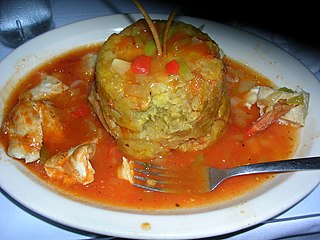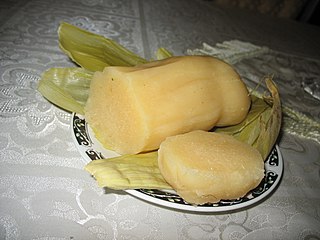
Cooking bananas are a group of banana cultivars in the genus Musa whose fruits are generally used in cooking. They are not eaten raw and are generally starchy. Many cooking bananas are referred to as plantains or 'green bananas'. In botanical usage, the term "plantain" is used only for true plantains, while other starchy cultivars used for cooking are called "cooking bananas". True plantains are cooking cultivars belonging to the AAB group, while cooking bananas are any cooking cultivar belonging to the AAB, AAA, ABB, or BBB groups. The currently accepted scientific name for all such cultivars in these groups is Musa × paradisiaca. Fe'i bananas from the Pacific Islands are often eaten roasted or boiled, and are thus informally referred to as "mountain plantains", but they do not belong to any of the species from which all modern banana cultivars are descended.

A cheesesteak is a sandwich made from thinly sliced pieces of beefsteak and melted cheese in a long hoagie roll. A popular regional fast food, it has its roots in the United States city of Philadelphia, Pennsylvania.

A fritter is a portion of meat, seafood, fruit, vegetables, or other ingredients which have been battered or breaded, or just a portion of dough without further ingredients, that is deep-fried. Fritters are prepared in both sweet and savory varieties.

Arepa is a type of flatbread made of ground maize dough stuffed with a filling, eaten in northern parts of South America since pre-Columbian times, and notable primarily in the cuisine of Colombia and Venezuela, but also present in Bolivia, Ecuador, and Central America.

A national dish is a culinary dish that is strongly associated with a particular country. A dish can be considered a national dish for a variety of reasons:

Kibbeh is a popular dish in the Levant based on spiced lean ground meat and bulgur wheat. Kibbeh is considered to be a national dish of Syria and Lebanon.

Mofongo is a dish from Puerto Rico with plantains as its main ingredient. Plantains are picked green, cut into pieces and typically fried in more modern versions but can be boiled in broth or roasted, then mashed with salt, garlic, broth, and cooking oil in a wooden pilón. Cassava and sweet potato are usually boiled and then flash-fried, plantains can also be made in this method or roasted before flash-frying. The goal is to produce a tight ball of mashed plantains that will absorb the attending condiments and have either pork cracklings (chicharrón) or bits of bacon inside. It is traditionally served with fried meat and chicken broth soup. Particular flavors result from variations that include vegetables, chicken, shrimp, beef, or octopus packed inside or around the plantain orb.

A chicken sandwich is a sandwich that typically consists of boneless, skinless chicken breast or thigh, served between slices of bread. Variations on the "chicken sandwich" include chicken on a bun, chicken on a Kaiser, hot chicken, or chicken salad sandwich.
Panamanian cuisine is a mix of Spanish, Indigenous, and African techniques, dishes, and ingredients, reflecting its diverse population. Since Panama is a land bridge between two continents, it has a large variety of tropical fruits, vegetables and herbs that are used in native cooking.

A bollo is a bun, popular in Latin America, made from corn, yuca, or potato. Variations are found in the cuisines of Colombia, Ecuador, Cuba and Panama. Corn and yuca bollos are an indigenous food of the Caribbean coast of Colombia and Panama, where they are boiled in leaves. This preparation is similar to the humita of the Andes, the hallaquita of Venezuela and the pamonha of Brazil.

Cheese soup is a type of soup prepared using cheese as a primary ingredient, along with milk, broth and/or stock to form its basis. Various additional ingredients are used in its preparation, and various types and styles of cheese soup exist. It is a part of some cuisines in the world, such as American, Colombian, Mexican, Swiss, French, and Tibetan cuisines. Mass-produced cheese soups may be prepared with the addition of food additives to preserve them and enhance flavor. A list of cheese soups is included in this article.

Willie's Place was a 15 acres (6.1 ha) truck stop and biodiesel processing plant located in Carl's Corner, Texas that was opened in 2005 and named after Willie Nelson. The facility was originally built circa 1980 by Carl Cornelius and named Carl's Corner. Willie's Place was closed for a time and then reopened in 2008 after a significant expansion. Willie's Place had a gas station that was the first to sell Willie Nelson Biodiesel brand biodiesel, a restaurant that specialized in Southern cuisine, a convenience store and a 750-seat concert theater for performances. The theater had a bar and a 1,000 square feet (93 m2) dance floor, and various touring country western bands would perform there.

Cristo Negro is a wooden statue of Jesus Christ in Iglesia de San Felipe in Portobelo, Panama. The statue was found on the shores of the town's harbour. Life size, it is adorned with a robe that is changed twice a year, once during the Festival of the Black Christ and during Holy Week. Black Christ is venerated throughout the year, most particularly on October 21, during the Festival of the Black Christ.

Rabbit stew, also referred to as hare stew when hare is used, is a stew prepared using rabbit meat as a main ingredient. Stuffat tal-Fenek, a variation of rabbit stew, is the national dish of Malta. Other traditional regional preparations of the dish exist, such as coniglio all'ischitana on the island of Ischia, German Hasenpfeffer and jugged hare in Great Britain and France. Hare stew dates back to at least the 14th century, and was published in The Forme of Cury during this time as a recipe for stewed hare. Rabbit stew is a traditional dish of the Algonquin people and is also a part of the cuisine of the Greek islands. Hare stew was commercially manufactured and canned circa the early 1900s in western France and eastern Germany.

A combination meal, often referred as a combo-meal, is a type of meal that typically includes food items and a beverage. They are a common menu item at fast food restaurants, and other restaurants also purvey them. Combination meals may be priced lower compared to ordering items separately, but this is not always the case. A combination meal is also a meal in which the consumer orders items à la carte to create their own meal combination.

A salumeria is a food producer and retail store that produces salumi and other food products. Some only sell foods, while not producing on-site, and some have a restaurant with sit-down service. The salumeria originated in Italy, and dates to the Middle Ages.















